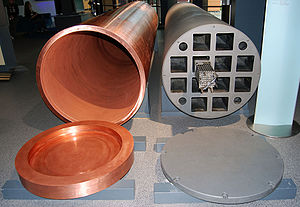
KBS-3
Encyclopedia

Radioactive waste
Radioactive wastes are wastes that contain radioactive material. Radioactive wastes are usually by-products of nuclear power generation and other applications of nuclear fission or nuclear technology, such as research and medicine...
developed in Sweden
Sweden
Sweden , officially the Kingdom of Sweden , is a Nordic country on the Scandinavian Peninsula in Northern Europe. Sweden borders with Norway and Finland and is connected to Denmark by a bridge-tunnel across the Öresund....
by Svensk Kärnbränslehantering AB (SKB) by appointment from Statens Strålskyddsinstitut (the government's radiation protection agency).
The disposal method consists of the following steps:
- The waste is first stored in intermediate storage for 30 years.
- The waste is encapsulated in ironIronIron is a chemical element with the symbol Fe and atomic number 26. It is a metal in the first transition series. It is the most common element forming the planet Earth as a whole, forming much of Earth's outer and inner core. It is the fourth most common element in the Earth's crust...
. - The iron capsule is encapsulated in copperCopperCopper is a chemical element with the symbol Cu and atomic number 29. It is a ductile metal with very high thermal and electrical conductivity. Pure copper is soft and malleable; an exposed surface has a reddish-orange tarnish...
(CuOFP alloy). - The capsule is deposited in a layer of bentoniteBentoniteBentonite is an absorbent aluminium phyllosilicate, essentially impure clay consisting mostly of montmorillonite. There are different types of bentonite, each named after the respective dominant element, such as potassium , sodium , calcium , and aluminum . Experts debate a number of nomenclatorial...
clay, in a circular hole, 8 meters deep and with a diameter of 2 meters, drilled in a cave 500 metres down into crystalline rock. - After the storage facility is full, the drill hole is sealed and the site marked.
- After 100,000 years (note 1) of storage, the radioactivity level of the waste is at the same level as that of uraniumUraniumUranium is a silvery-white metallic chemical element in the actinide series of the periodic table, with atomic number 92. It is assigned the chemical symbol U. A uranium atom has 92 protons and 92 electrons, of which 6 are valence electrons...
oreOreAn ore is a type of rock that contains minerals with important elements including metals. The ores are extracted through mining; these are then refined to extract the valuable element....
mined to make the fuel.
The first facility using this method will be located in Östhammar
Östhammar
Östhammar is a locality and the seat of Östhammar Municipality, Uppsala County, Sweden with 4,534 inhabitants in 2010. Today Östhammar Municipality is a part of Uppsala County, but the area has historically been a part of Stockholm County.-History:...
, Sweden
Sweden
Sweden , officially the Kingdom of Sweden , is a Nordic country on the Scandinavian Peninsula in Northern Europe. Sweden borders with Norway and Finland and is connected to Denmark by a bridge-tunnel across the Öresund....
. The location was selected in 2009 as part of a multi-year competition with the towns of Forsmark
Forsmark
Forsmark is a village with 59 inhabitants on the east coast of Uppland, Sweden. It is most known as the location of the Forsmark Nuclear Power Plant....
and Oskarshamn
Oskarshamn
Oskarshamn is a coastal city and the seat of Oskarshamn Municipality, Kalmar County, Sweden with 17,258 inhabitants in 2010.-History:The location of Oskarshamn was known as Döderhultsvik since the Medieval age...
.
The facility will have space for 6000 capsules and the plan is to deposit 200 capsules in the storage annually. The technology was developed by studying different natural storage facilities such as the natural reactor
Natural nuclear fission reactor
A natural nuclear fission reactor is a uranium deposit where analysis of isotope ratios has shown that self-sustaining nuclear chain reactions have occurred. The existence of this phenomenon was discovered in 1972 at Oklo in Gabon, Africa, by French physicist Francis Perrin. The conditions under...
in Oklo
Oklo
Oklo is a region near the town of Franceville, in the Haut-Ogooué province of the Central African state of Gabon. Several natural nuclear fission reactors were discovered in the uranium mines in the region in 1972.-History:...
in Gabon
Gabon
Gabon , officially the Gabonese Republic is a state in west central Africa sharing borders with Equatorial Guinea to the northwest, Cameroon to the north, and with the Republic of the Congo curving around the east and south. The Gulf of Guinea, an arm of the Atlantic Ocean is to the west...
and the uranium mine in Cigar Lake, Canada
Canada
Canada is a North American country consisting of ten provinces and three territories. Located in the northern part of the continent, it extends from the Atlantic Ocean in the east to the Pacific Ocean in the west, and northward into the Arctic Ocean...
.
If the holes into the rock from the cave are drilled vertically, the method is called KBS-3V and if they are drilled horizontally it is called KBS-3H. The only method considered so far is KBS-3V.
Note 1. Benedict, Pigford and Levi show data (Figure 11.2) indicating that enriched fuel from a light water reactor, subjected to a typical burnup regime will be no more radioactive than the ore from which it was mined, after a period of about six hundred years.
External links
- Djupförvarets barriärer (in SwedishSwedish languageSwedish is a North Germanic language, spoken by approximately 10 million people, predominantly in Sweden and parts of Finland, especially along its coast and on the Åland islands. It is largely mutually intelligible with Norwegian and Danish...
) - Final repository (same as above, but in EnglishEnglish languageEnglish is a West Germanic language that arose in the Anglo-Saxon kingdoms of England and spread into what was to become south-east Scotland under the influence of the Anglian medieval kingdom of Northumbria...
)

